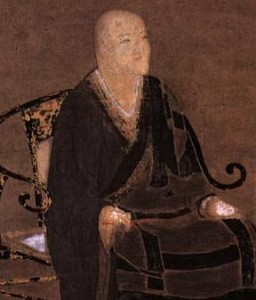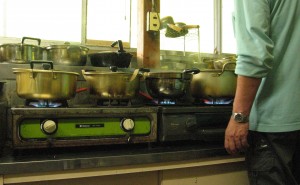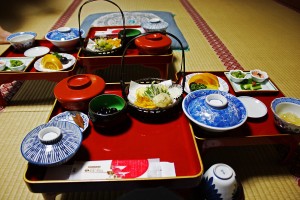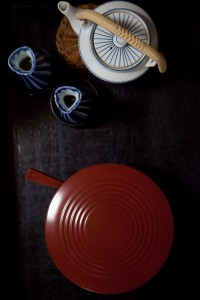
8 NOVEMBRE 2015 | PAR SOPHIE RAOBEHARILALA
Japanese cuisine is well-known in the West for its refined healthy and delicious qualities. Culinary terms such as tempura, soba, maki, tofu are common knowledge to many and have even appeared on our menus. What initially was considered as an alternative for vegetarians became as highly praised as French cuisine around the world. However, little are aware of its origins, going back to 13th century Buddhism and temple cooking. Indeed Japanese cuisine illustrates perfectly food heritage transmission over the centuries for very little changes have occurred in the techniques and ingredients.
In order to understand the profound link between everyday food and religion, we will first have a look at the evolution of religion in Japan.
Buddhism was introduced in Japan during the 6th century with the arrival of Chinese and Korean immigrants who were practising in their homes. Eventhough Buddhism originated from India, certain forms had been slightly transformed and adapted by China, essentially the Māhāyānā1 doctrine, which arrived in Japan. The Sacred language of Japanese Buddhism was therefore literary Chinese. It is only recently that the translation of Sacred writings into modern Japanese has occurred.
Two main zen schools of Buddhism emerged in the country during the 13th century : the Rinzai2 school which was the key factor to a Chinese influence on the Japanese culture, especially in the nobility sphere ; the Sōtō3 school which appealed more to samouraïs because of its simplicity and sobriety. We will focus on the latter for the Sōtō school is the main influence in Japanese cuisine.
 The Sōtō school (Sōtō-Shū) was founded by Dōgen4 who was introduced to zen teachings by Eisai, followed by a thorough practise of Sōtō during four years in China. Dōgen chose to diffuse his zen knowledge in Eihei-ji monasteries around the country. His major work Shōbōgenzō5 has become a milestone in Japanese Buddhism. Thus it is during the 13th century that zen Buddhism had its advent along with zen cuisine. Further on the Edo6 era saw zen practices spread in nearly every home of Japan for Buddhist temples had a great influence in society.
The Sōtō school (Sōtō-Shū) was founded by Dōgen4 who was introduced to zen teachings by Eisai, followed by a thorough practise of Sōtō during four years in China. Dōgen chose to diffuse his zen knowledge in Eihei-ji monasteries around the country. His major work Shōbōgenzō5 has become a milestone in Japanese Buddhism. Thus it is during the 13th century that zen Buddhism had its advent along with zen cuisine. Further on the Edo6 era saw zen practices spread in nearly every home of Japan for Buddhist temples had a great influence in society.
During the 18th century and the Edo era, when Kyōtō was the capital city of the empire the city comprised an important number of temples which were the meeting-points and sources of knowledge for the Japanese elite and great minds.
Zen principles deeply became part of Japanese everyday life. When it came to eating, zen cuisine was the reference.
« Monks have used their religion to create a cooking style which would convert the most unyielding non-vegetarian »7.
Temples served Shojin-Ryori8 cuisine which materialised the link between Buddhist teachings on compassion for evey form of life and vegetarism. There is a strict protocole to preparing and eating a meal, seen a form of Shugyo9.
In a Buddhist temple, the task of cooking is assigned to the Tenzo (or zen cook). This function is given to enlightened masters seeking for the Awakening. Dōgen has written a collection of rules dedicated to the Tenzo’s practices, which have been included in the Zenonshingi (monastery’s regulations).  In temples ingredients are provided by donations from the community. The Tenzo must therefore consider and treat them with the utmost respect for not only are they a product of the Earth but they are also a gift from others. As a result, the benefits of the ingredients and of their treatment will be passed on to the eater who will reach a new step in harmony and zen. The protocole requires the establishment of a menu by the temple’s administrators who have to deliberate on the flavours selected and the preparation of the meal. The Tenzo must find the right balance between the Six Flavours (bitter, sour, sweet, spicy, salty, bland) and the Three Virtues (flexibility-lightness, clarity-freshness, care-precision). The protocole also states that food preparations are to be done before midnight and cooking after midnight.
In temples ingredients are provided by donations from the community. The Tenzo must therefore consider and treat them with the utmost respect for not only are they a product of the Earth but they are also a gift from others. As a result, the benefits of the ingredients and of their treatment will be passed on to the eater who will reach a new step in harmony and zen. The protocole requires the establishment of a menu by the temple’s administrators who have to deliberate on the flavours selected and the preparation of the meal. The Tenzo must find the right balance between the Six Flavours (bitter, sour, sweet, spicy, salty, bland) and the Three Virtues (flexibility-lightness, clarity-freshness, care-precision). The protocole also states that food preparations are to be done before midnight and cooking after midnight.
Shōjin Ryōri is cooked with water only and includes food taboos such as meat, crustaceans and fish, alcohol and the five herbs from the lily family (onion, garlic, leek, shalot, scallion), considered as stimulating. This cuisine is based on season vegetables : in Spring new sprouts are on the menu, in Summer we found green leaves, in Autumn more fruits and nuts, and in Winter it will be roots. The use of vegetable oil quite low in fat is common, especially sesame seed oil. Sesame seeds and nuts are rich in lipid and are often used as a base for sauces complementing vegetables. The use of wheat gluten (fu) also compensates the absence of animal protein. Broth is prepared with konbu (edible kelp), and dried mushrooms. The use of dried mushroom is thought through as the liquid extracted from its rehydration is used for soups whereas the rehydrated mushroom itself is cooked in other preparations. Shōjin Ryōri ingredients are soft and nutritional but without much taste. This explains the addition of different kinds of tofu (yuba and nattō) to enrich the taste.
Initially during the Edo era, Shinjō-Ryōri cuisine was prepared during monthly or annual ceremonies in honour of the deads. Vegetarian meals were regularly served during this week. However tea ceremonies also had Shōjin Ryōri cuisine, better known as Kaiseki Ryōri. But if this cuisine started to appear in homes for specific occasions, it rapidly expanded to everyday cuisine. Parishioners went to temples for cooking lessons and advice in order to feed the family following this regime. The popularity of such cuisine also comes from its ingredients : not only is there a wide variety of ingredients used for preparations but Japan has an abundant source of vegetables, cultivated as well as wild.
 If zen cuisine has a protocole for preparing, there are also ways of serving the meal. Initially monks used to eat their food in individual bowls, sitting on the floor. With the enthusiasm for zen cuisine, visitors were invited to take part to monks’ meals, which lead to a service on honzen10.
If zen cuisine has a protocole for preparing, there are also ways of serving the meal. Initially monks used to eat their food in individual bowls, sitting on the floor. With the enthusiasm for zen cuisine, visitors were invited to take part to monks’ meals, which lead to a service on honzen10.
 During the 17th century appeared a new style of zen cuisine : Fucha Ryōri. Introduced by a Chinese monk named Ingen, the cooking wasn’t based on water but rather on oil as ingredients were fried, then deepened in a starch stock to bring some consistence. This cooking has much in common with modern Chinese cuisine sù cài11. Most of the preparations’ names come from Chinese words. When Shōjin-Ryōri is taken on the floor with individual bowls, Fucha Ryōri is taken at the table and served in a shared dish. Fucha Ryōri remains a vegetarian cuisine and it is eaten whilst drinking tea.
During the 17th century appeared a new style of zen cuisine : Fucha Ryōri. Introduced by a Chinese monk named Ingen, the cooking wasn’t based on water but rather on oil as ingredients were fried, then deepened in a starch stock to bring some consistence. This cooking has much in common with modern Chinese cuisine sù cài11. Most of the preparations’ names come from Chinese words. When Shōjin-Ryōri is taken on the floor with individual bowls, Fucha Ryōri is taken at the table and served in a shared dish. Fucha Ryōri remains a vegetarian cuisine and it is eaten whilst drinking tea.
When looking at today’s Japanese cuisine, we recognise ingredients and preparations from both Shōjin Ryōri and Fucha Ryōri. Meat and fish have been added to the menu and preparations but techniques and recipes have barely changed. The religious approach of this cuisine might not have remained fully, but the harmony of flavours, the benefits of ingredients on the body, both leading to the harmony of Japanese people with their land certainly contributes to the perpetuity of this cooking-style, so much so that it is admired and praised in the West as highly gastronomic.
1Māhāyānā : one of two (or three, under some classifications) main existing branches of Buddhism and a term for classification of Buddhist philosophies and practice. It refers to the path of the Bodhisattva seeking complete enlightenment for the benefit of all sentient beings, also called « Bodhisattvayāna », or the « Bodhisattva Vehicle ».
2Rinzai : Rinzai is the Japanese line of the Linji school, which was founded during the Tang Dynasty by Linji Yixuan Chinese
3Sōtō : the largest of the three traditional sects of Zen in Japanese Buddhism.
4Dōgen (1200-1253) : a Japanese Buddhist priest, writer, poet, philosopher, and founder of the Sōtō school of Zen in Japan.
5Shōbōgenzo: lit. « Treasury of the True Dharma Eye » is the title most commonly used to refer to the collection of works written in Japanese by the 13th century Japanese Buddhist monk and founder of the Japanese Sōtō Zen school, Eihei Dōgen.
6Edo era (1603-1868) : Edo was the ancient name of Tokyo. It was the seat of power for the Tokugawa shogunate, which ruled Japan from 1603 to 1868. During this period, it grew to become one of the largest cities in the world
7From Les Grandes traditions culinaires : Japon, Kiyoshi Hayamizu & Yuhei Hoshimo, 1995 Time-Life PARIS.
8Shōjin Ryōri : Shōjin relates to living a life in purity following the virtue of vegetarism. Shōjin Ryōri therefore means devotion cuisine.
9Shugyo: Japanese expression from the Pax Tokugawa era (1650-1850) or samouraï times, meaning intensive training. It is usually used in martial arts and zen.
10Honzen : legged-tray
11Sù cài : (or Jiangsu cài) is one of the Eight Culinary Traditions of Chinese cuisine, comes from the Jiangsu province.